Random Forest Classification of Multitemporal Landsat 8 Spectral Data and Phenology Metrics for Land Cover Mapping in the Sonoran and Mojave Deserts
Abstract
:1. Introduction
Objectives
- Train an ML model to classify vegetation land cover using remote sensing spectral data and phenology metrics from 2013 to 2020, over a large subregion of the Sonoran and Mojave Deserts BCR.
- Calibrate, validate, and refine the final ML-derived vegetation map using a collection of openly sourced remote sensing and ground-based ancillary data, images, and limited fieldwork.
- Harmonize a new transboundary classification system by expanding existing land cover mapping resources from the US portion of BCR 33 into MX.
2. Data and Methods
2.1. Study Area
2.2. Reference Land Cover Maps
2.2.1. GAP/LANDFIRE National Terrestrial Ecosystems 2011
2.2.2. INEGI Land Use and Vegetation
2.2.3. Ancillary Maps
2.3. Landsat 8 OLI Data Collection and Processing
2.4. Extraction of Phenology Metrics
2.5. Land Cover Sampling Design
2.6. RF Classifier
2.7. Evaluation and Comparison of Classification Results
3. Results
3.1. Sampling Size
3.2. Classification Accuracy
3.3. Classification of the Entire Study Area
3.4. Data Analysis
4. Discussions
4.1. RF Model Performance
4.2. Evaluation of Results in Mexico
5. Conclusions
Supplementary Materials
Author Contributions
Funding
Data Availability Statement
Acknowledgments
Conflicts of Interest
References
- Thornton, D.H.; Wirsing, A.J.; Lopez-Gonzalez, C.; Squires, J.R.; Fisher, S.; Larsen, K.W.; Peatt, A.; Scrafford, M.A.; Moen, R.A.; Scully, A.E.; et al. Asymmetric Cross-border Protection of Peripheral Transboundary Species. Conserv. Lett. 2018, 11, e12430. [Google Scholar] [CrossRef] [Green Version]
- Wehncke, E.V.; Lara-Lara, J.R.; Álvarez-Borrego, S.; Ezcurra, E. Conservation Science in Mexico’s Northwest; Independent Publisher: Chicago, IL, USA, 2014; ISBN 9781495122224. [Google Scholar]
- Nagendra, H.; Lucas, R.; Honrado, J.P.; Jongman, R.H.G.; Tarantino, C.; Adamo, M.; Mairota, P. Remote Sensing for Conservation Monitoring: Assessing Protected Areas, Habitat Extent, Habitat Condition, Species Diversity, and Threats. Ecol. Indic. 2013, 33, 45–59. [Google Scholar] [CrossRef]
- Rodríguez-Maturino, A.; Martínez-Guerrero, J.H.; Chairez-Hernández, I.; Pereda-Solis, M.E.; Villarreal-Guerrero, F.; Renteria-Villalobos, M.; Pinedo-Alvarez, A. Mapping Land Cover and Estimating the Grassland Structure in a Priority Area of the Chihuahuan Desert. Land 2017, 6, 70. [Google Scholar] [CrossRef] [Green Version]
- Horning, N.; Robinson, J.A.; Sterling, E.J.; Turner, W.; Spector, S. Remote Sensing for Ecology and Conservation: A Handbook of Techniques; Oxford University Press: New York, NY, USA, 2010; ISBN 9780199219940. [Google Scholar]
- (CalPIF) California Partners in Flight. The Desert Bird Conservation Plan: A Strategy for Protecting and Managing Desert Habitats and Associated Birds in California, Version 1.0; California Partners in Flight: Crescent, CA, USA, 2009. [Google Scholar]
- Martell, A.; Berlanga, H.; Pashley, D.; Hoth, J. Review of Progress on the North American Bird Conservation Initiative; North American Bird Conservation Initiative, NABCI: Gatineau, QC, Canada, 2002. [Google Scholar]
- Flesch, A.D.; Nagler, P.; Jarchow, C.J.; Richardson, S. Population trends, extinction risk, and conservation guidelines for ferruginous pygmy-owls in the Sonoran Desert. In Final Report for Science Support Partnership Project between U.S. Geological Survey, U.S. Fish and Wildlife Service; Cooperative Agreement No. G15AC00133; University of Arizona, School of Natural Resources and the Environment: Tucson, Arizona, 2017. [Google Scholar]
- Flesch, A.D. Cactus Ferruginous Pygmy-Owl monitoring and habitat on Pima County Conservation Lands. Report to Pima County Office of Sustainability and Conservation; Contract No. CT-SUS-20-195; University of Arizona, School of Natural Resources and the Environment: Tucson, Arizona, 2021. [Google Scholar]
- Elkind, K.; Sankey, T.T.; Munson, S.M.; Aslan, C.E. Invasive Buffelgrass Detection Using High-resolution Satellite and UAV Imagery on Google Earth Engine. Remote Sens. Ecol. Conserv. 2019, 5, 318–331. [Google Scholar] [CrossRef]
- Franklin, K.A.; Lyons, K.; Nagler, P.L.; Lampkin, D.; Glenn, E.P.; Molina-Freaner, F.; Markow, T.; Huete, A.R. Buffelgrass (Pennisetum Ciliare) Land Conversion and Productivity in the Plains of Sonora, Mexico. Biol. Conserv. 2006, 127, 62–71. [Google Scholar] [CrossRef]
- Pérez-Valladares, C.X.; Velázquez, A.; Moreno-Calles, A.I.; Mas, J.F.; Torres-García, I.; Casas, A.; Rangel-Landa, S.; Blancas, J.; Vallejo, M.; Téllez-Valdés, O. An Expert Knowledge Approach for Mapping Vegetation Cover Based upon Free Access Cartographic Data: The Tehuacan-Cuicatlan Valley, Central Mexico. Biodivers. Conserv. 2019, 28, 1361–1388. [Google Scholar] [CrossRef]
- Homer, C.; Huang, C.; Yang, L.; Wylie, B.; Coan, M. Development of a 2001 National Land-Cover Database for the United States. Photogramm. Eng. Remote Sens. 2004, 70, 829–840. [Google Scholar] [CrossRef] [Green Version]
- Knight, J.F.; Lunetta, R.S.; Ediriwickrema, J.; Khorram, S. Regional Scale Land Cover Characterization Using MODIS-NDVI 250 m Multi-Temporal Imagery: A Phenology-Based Approach. GIScience Remote Sens. 2006, 43, 1361–1388. [Google Scholar] [CrossRef]
- Villarreal, M.L.; Norman, L.M.; Wallace, C.S.A.; van Riper, C., III. A Multitemporal (1979–2009) Land-Use/Land-Cover Dataset of the Binational Santa Cruz Watershed; Open-File Report 2011-1131; U.S. Geological Survey: Reston, VA, USA, 2011; 26p.
- Shetty, S.; Gupta, P.K.; Belgiu, M.; Srivastav, S.K. Assessing the Effect of Training Sampling Design on the Performance of Machine Learning Classifiers for Land Cover Mapping Using Multi-Temporal Remote Sensing Data and Google Earth Engine. Remote Sens. 2021, 13, 1433. [Google Scholar] [CrossRef]
- Simonetti, E.; Simonetti, D.; Preatoni, D. Phenology-Based Land Cover Classification Using Landsat 8 Time Series; Publications Office of the European Union: Luxembourg, 2014; ISBN 9789279408441. [Google Scholar]
- White, M.A.; Thornton, P.E.; Running, S.W. A Continental Phenology Model for Monitoring Vegetation Responses to Interannual Climatic Variability. Glob. Biogeochem. Cycles 1997, 11, 217–234. [Google Scholar] [CrossRef]
- Van Leeuwen, W.J.D.; Davison, J.E.; Casady, G.M.; Marsh, S.E. Phenological Characterization of Desert Sky Island Vegetation Communities with Remotely Sensed and Climate Time Series Data. Remote Sens. 2010, 2, 388–415. [Google Scholar] [CrossRef] [Green Version]
- Belgiu, M.; Drăguţ, L. Random Forest in Remote Sensing: A Review of Applications and Future Directions. ISPRS J. Photogramm. Remote Sens. 2016, 114, 24–31. [Google Scholar] [CrossRef]
- Khatami, R.; Mountrakis, G.; Stehman, S.V. A Meta-Analysis of Remote Sensing Research on Supervised Pixel-Based Land-Cover Image Classification Processes: General Guidelines for Practitioners and Future Research. Remote Sens. Environ. 2016, 177, 89–100. [Google Scholar] [CrossRef] [Green Version]
- Zhu, Z.; Gallant, A.L.; Woodcock, C.E.; Pengra, B.; Olofsson, P.; Loveland, T.R.; Jin, S.; Dahal, D.; Yang, L.; Auch, R.F. Optimizing Selection of Training and Auxiliary Data for Operational Land Cover Classification for the LCMAP Initiative. ISPRS J. Photogramm. Remote Sens. 2016, 122, 206–221. [Google Scholar] [CrossRef] [Green Version]
- Gebhardt, S.; Maeda, P.; Wehrmann, T.; Argumedo Espinoza, J.; Schmidt, M. A Proper Land Cover and Forest Type Classification Scheme for Mexico. Int. Arch. Photogramm. Remote Sens. Spat. Inf. Sci. 2015, XL-7W3, 383–390. [Google Scholar] [CrossRef] [Green Version]
- Li, W.; Dong, R.; Fu, H.; Wang, J.; Yu, L.; Gong, P. Integrating Google Earth Imagery with Landsat Data to Improve 30-m Resolution Land Cover Mapping. Remote Sens. Environ. 2020, 237, 111563. [Google Scholar] [CrossRef]
- Bird Studies Canada and NABCI. Bird Conservation Regions. Published by Bird Studies Canada on Behalf of the North American Bird Conservation Initiative. 2014. Available online: https://birdscanada.org/bird-science/nabci-bird-conservation-regions (accessed on 5 May 2022).
- U.S. National Park Service. Sonoran Desert Network Ecosystems. Available online: https://www.nps.gov/im/sodn/ecosystems.htm (accessed on 3 February 2023).
- U.S. Geological Survey. 3D Elevation Program 1-Meter Resolution Digital Elevation Model. Available online: https://www.usgs.gov/the-national-map-data-delivery (accessed on 1 February 2023).
- U.S. Geological Survey (USGS) Gap Analysis Project (GAP). GAP/LANDFIRE National Terrestrial Ecosystems 2011; U.S. Geological Survey Data Release: Reston, VA, USA, 2016.
- Comer, P.D.; Faber-Langendoen, R.; Evans, S.; Gawler, C.; Josse, G.; Kittel, S.; Menard, M.; Pyne, M.; Reid, K. Ecological Systems of the United States: A Working Classification of U.S. Terrestrial Systems; NatureServe: Arlington, VA, USA, 2003. [Google Scholar]
- National Institute of Statistics, Geography, and Informatics (INEGI). Use of Soil and Vegetation; Serie VII; National Institute of Statistics, Geography, and Informatics (INEGI): Aguascalientes, Mexico, 2018. [Google Scholar]
- Instituto Nacional de Estadística y Geografía (México). Guía Para la Interpretación de Cartografía: Uso del Suelo y Vegetación: Escala 1:250,000, Serie VI; Instituto Nacional de Estadística y Geografía: Aguascalientes, Mexico, 2017. [Google Scholar]
- Rzedowski, J.; Huerta, M.L. Vegetación de México, 1st ed.; Editorial Limusa: CDMX, Mexico, 1978. [Google Scholar]
- Miranda, F.; Hernández-X, E. Los tipos de vegetación de México y su clasificación. Bot. Sci. 2016, 28, 29–179. [Google Scholar] [CrossRef] [Green Version]
- National Institute of Statistics, Geography, and Informatics (INEGI). Geography and Environment: Use of Soil and Vegetation. INEGI. Available online: https://inegi.org.mx/temas/usosuelo/ (accessed on 24 March 2022).
- Boryan, C.; Yang, Z.; Mueller, R.; Craig, M. Monitoring US Agriculture: The US Department of Agriculture, National Agricultural Statistics Service, Cropland Data Layer Program. Geocarto Int. 2011, 26, 341–358. [Google Scholar] [CrossRef]
- United States Department of Agriculture (USDA). National Agricultural Statistics Service 2021 Cropland Data Layer (CDL); United States Department of Agriculture: Washington, DC, USA, 2022. [Google Scholar]
- United States Department of Agriculture (USDA) National Agricultural Statistics Service. Cropland Data Layer—National Download. Available online: https://www.nass.usda.gov/Research_and_Science/Cropland/Release/ (accessed on 7 April 2022).
- U.S. Fish and Wildlife Services. Wetlands Mapper Documentation and Instructions Manual; Guidance Document; U. S. Fish and Wildlife Services: Atlanta, GA, USA, 2019.
- U.S. Fish and Wildlife Services. National Wetlands Inventory Website. Available online: https://www.fws.gov/program/national-wetlands-inventory/wetlands-data (accessed on 9 December 2022).
- Standart, G.D.; Stulken, K.R.; Zhang, X.; Zong, Z.L. Geospatial Visualization of Global Satellite Images with Vis-EROS. Environ. Model. Softw. 2011, 26, 980–982. [Google Scholar] [CrossRef]
- Jiang, Z.; Huete, A.; Didan, K.; Miura, T. Development of a Two-Band Enhanced Vegetation Index without a Blue Band. Remote Sens. Environ. 2008, 112, 3833–3845. [Google Scholar] [CrossRef]
- Huete, A.; Didan, K.; Miura, T.; Rodriguez, E.P.; Gao, X.; Ferreira, L.G. Overview of the Radiometric and Biophysical Performance of the MODIS Vegetation Indices. Remote Sens. Environ. 2002, 83, 195–213. [Google Scholar] [CrossRef]
- White, M.A.; de Beurs, K.M.; Didan, K.; Inouye, D.W.; Richardson, A.D.; Jensen, O.P.; O’Keefe, J.; Zhang, G.; Nemani, R.R.; van Leeuwen, W.J.D.; et al. Intercomparison, Interpretation, and Assessment of Spring Phenology in North America Estimated from Remote Sensing for 1982–2006. Glob. Chang. Biol. 2009, 15, 2335–2359. [Google Scholar] [CrossRef]
- Didan, K.; Munoz, A.B.; Miura, T.; Tsend-Ayush, J.; Zhang, X.; Friedl, M.; Gray, J.; Van Leeuwen, W.; Czapla-Myers, J.; Jenkerson, C.; et al. Multi-Sensor Vegetation Index and Phenology Earth Science Data Records Algorithm Theoretical Basis Document and User Guide; NASALP-DAAC: Sioux Falls, SD, USA, 2015. [Google Scholar]
- Reed, B.C.; Brown, J.F.; VanderZee, D.; Loveland, T.R.; Merchant, J.W.; Ohlen, D.O. Measuring Phenological Variability from Satellite Imagery. J. Veg. Sci. 1994, 5, 703–714. [Google Scholar] [CrossRef]
- Naboureh, A.; Ebrahimy, H.; Azadbakht, M.; Bian, J.; Amani, M. RUESVMs: An Ensemble Method to Handle the Class Imbalance Problem in Land Cover Mapping Using Google Earth Engine. Remote Sens. 2020, 12, 3484. [Google Scholar] [CrossRef]
- Douzas, G.; Bacao, F.; Fonseca, J.; Khudinyan, M. Imbalanced Learning in Land Cover Classification: Improving Minority Classes’ Prediction Accuracy Using the Geometric SMOTE Algorithm. Remote Sens. 2019, 11, 3040. [Google Scholar] [CrossRef] [Green Version]
- McKerrow, A.J.; Davidson, A.; Earnhardt, T.S.; Benson, A.L. Integrating Recent Land Cover Mapping Efforts to Update the National Gap Analysis Program’s Species Habitat Map. Int. Arch. Photogramm. Remote Sens. Spat. Inf. Sci. 2014, XL–1, 245–252. [Google Scholar] [CrossRef] [Green Version]
- Fernández, A.; García, S.; Galar, M.; Prati, R.C.; Krawczyk, B.; Herrera, F. Learning from Imbalanced Data Sets; Springer International Publishing: Cham, Switzerland, 2018; ISBN 978-3-319-98073-7. [Google Scholar]
- Gorelick, N.; Hancher, M.; Dixon, M.; Ilyushchenko, S.; Thau, D.; Moore, R. Google Earth Engine: Planetary-Scale Geospatial Analysis for Everyone. Remote Sens. Environ. 2017, 202, 18–27. [Google Scholar] [CrossRef]
- Breiman, L. Random Forests. Mach. Learn. 2001, 45, 5–32. [Google Scholar] [CrossRef] [Green Version]
- Van Rossum, G.; Drake, F.L. Python 3 Reference Manual; CreateSpace: Scotts Valley, CA, USA, 2009; ISBN 1-4414-1269-7. [Google Scholar]
- Pedregosa, F.; Varoquaux, G.; Gramfort, A.; Michel, V.; Thirion, B.; Grisel, O.; Blondel, M.; Prettenhofer, P.; Weiss, R.; Dubourg, V.; et al. Scikit-Learn: Machine Learning in Python. J. Mach. Learn. Res. 2011, 12, 2825–2830. [Google Scholar]
- ArcGIS Desktop; Esri Inc.: Redlands, CA, USA, 2020.
- Chawla, N.V.; Bowyer, K.W.; Hall, L.O.; Kegelmeyer, W.P. SMOTE: Synthetic Minority Over-Sampling Technique. J. Artif. Intell. Res. 2002, 16, 321–357. [Google Scholar] [CrossRef]
- Nguyen, C.T.; Chidthaisong, A.; Kieu Diem, P.; Huo, L.-Z. A Modified Bare Soil Index to Identify Bare Land Features during Agricultural Fallow-Period in Southeast Asia Using Landsat 8. Land 2021, 10, 231. [Google Scholar] [CrossRef]
- Méndez-Barroso, L.A.; Vivoni, E.R.; Watts, C.J.; Rodríguez, J.C. Seasonal and Interannual Relations between Precipitation, Surface Soil Moisture and Vegetation Dynamics in the North American Monsoon Region. J. Hydrol. 2009, 377, 59–70. [Google Scholar] [CrossRef]
- Melichar, M.; Didan, K.; Barreto-Muñoz, A.; Duberstein, J.; Nagler, P. Random Forest Classification Data Developed from Multitemporal Landsat 8 Spectral Data and Phenology Metrics for a Subregion in Sonoran and Mojave Deserts, April 2013–December 2020; U.S. Geological Survey Data Release: Reston, VA, USA, 2023.




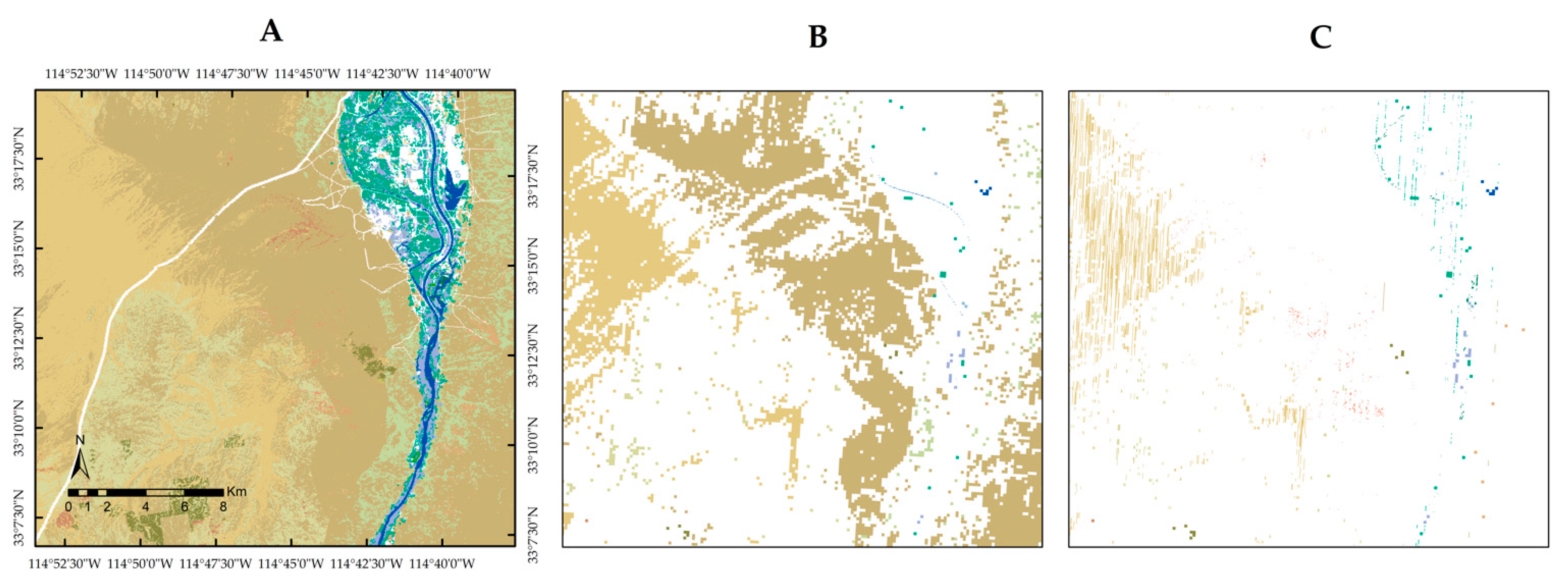
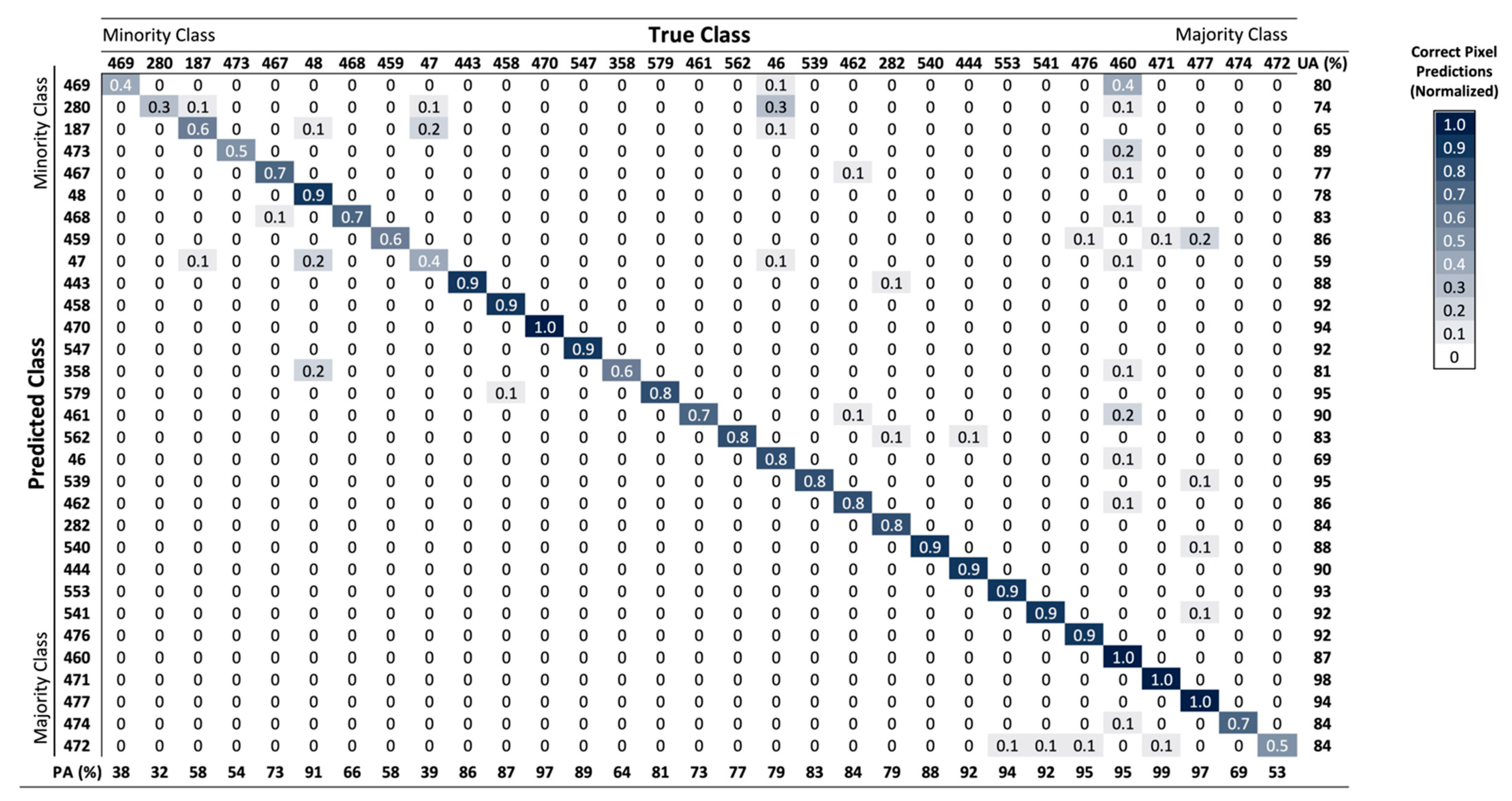

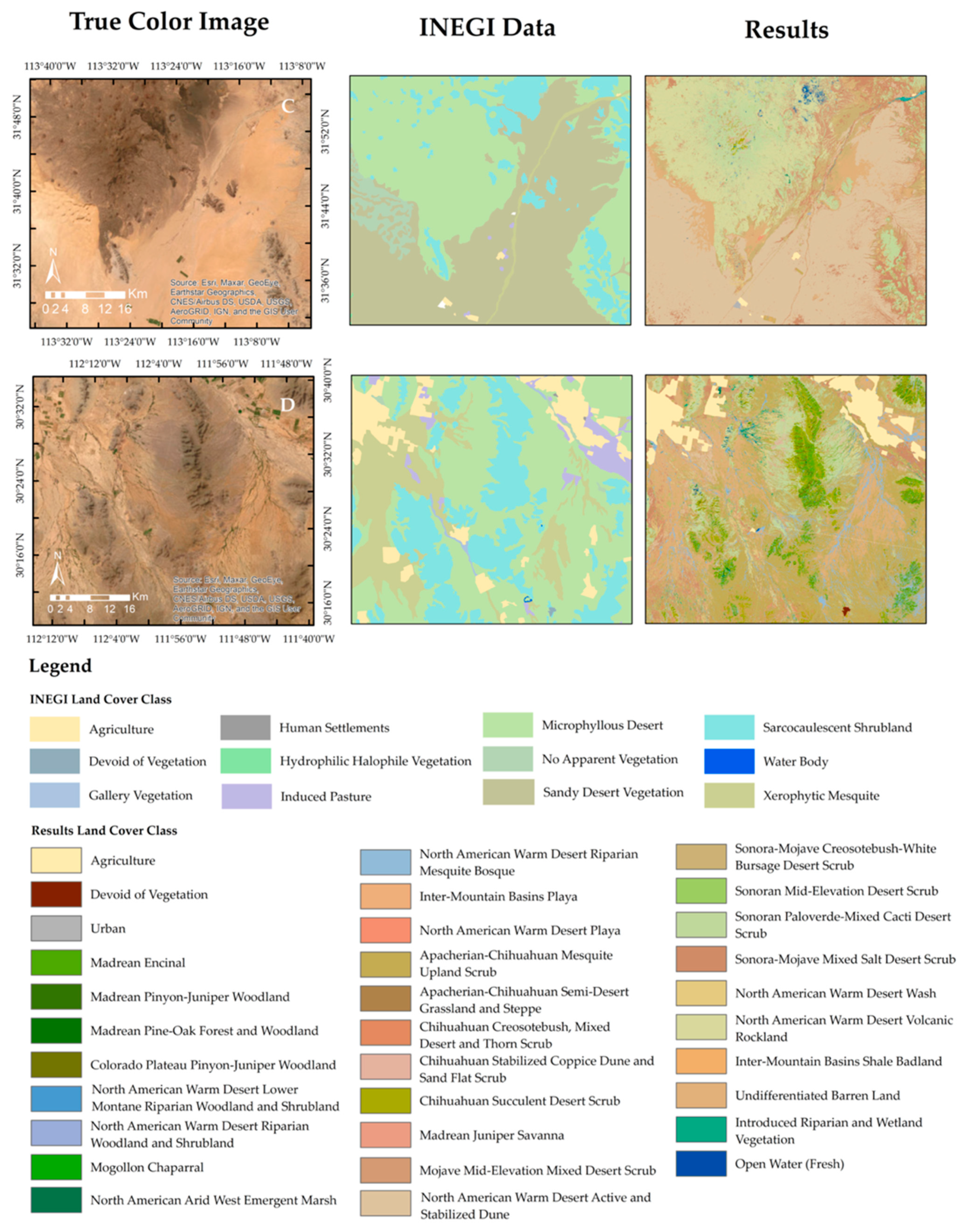
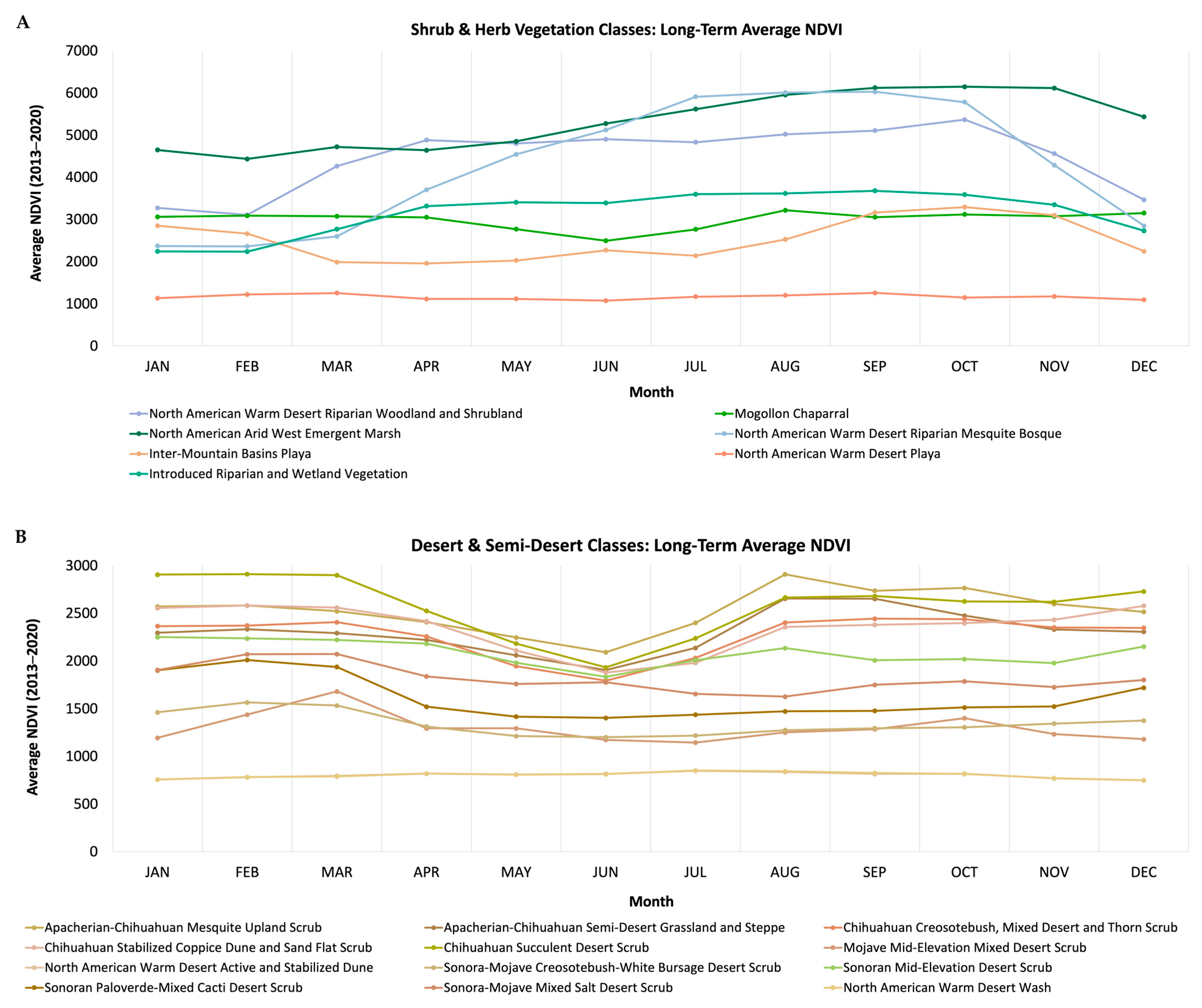
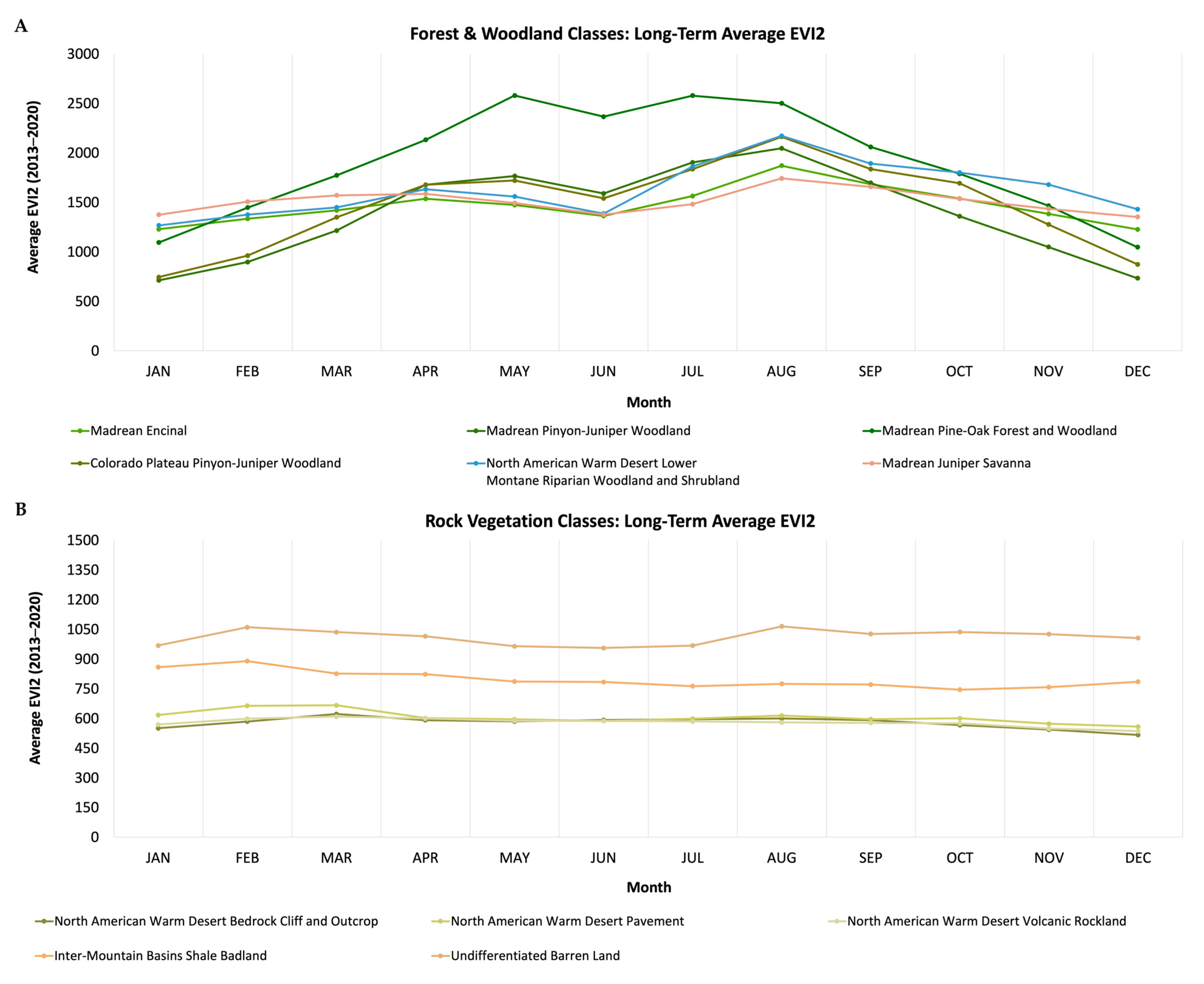
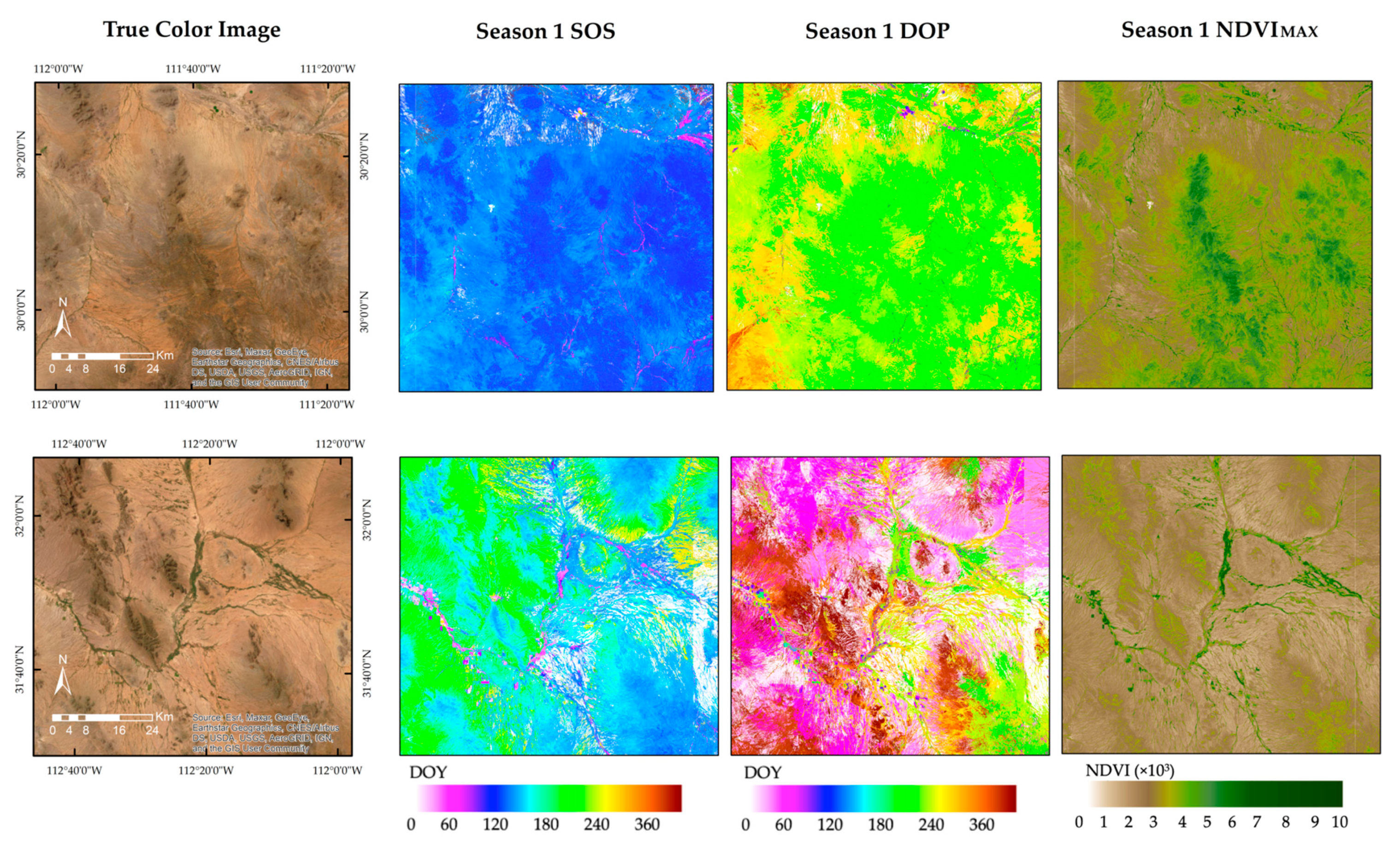
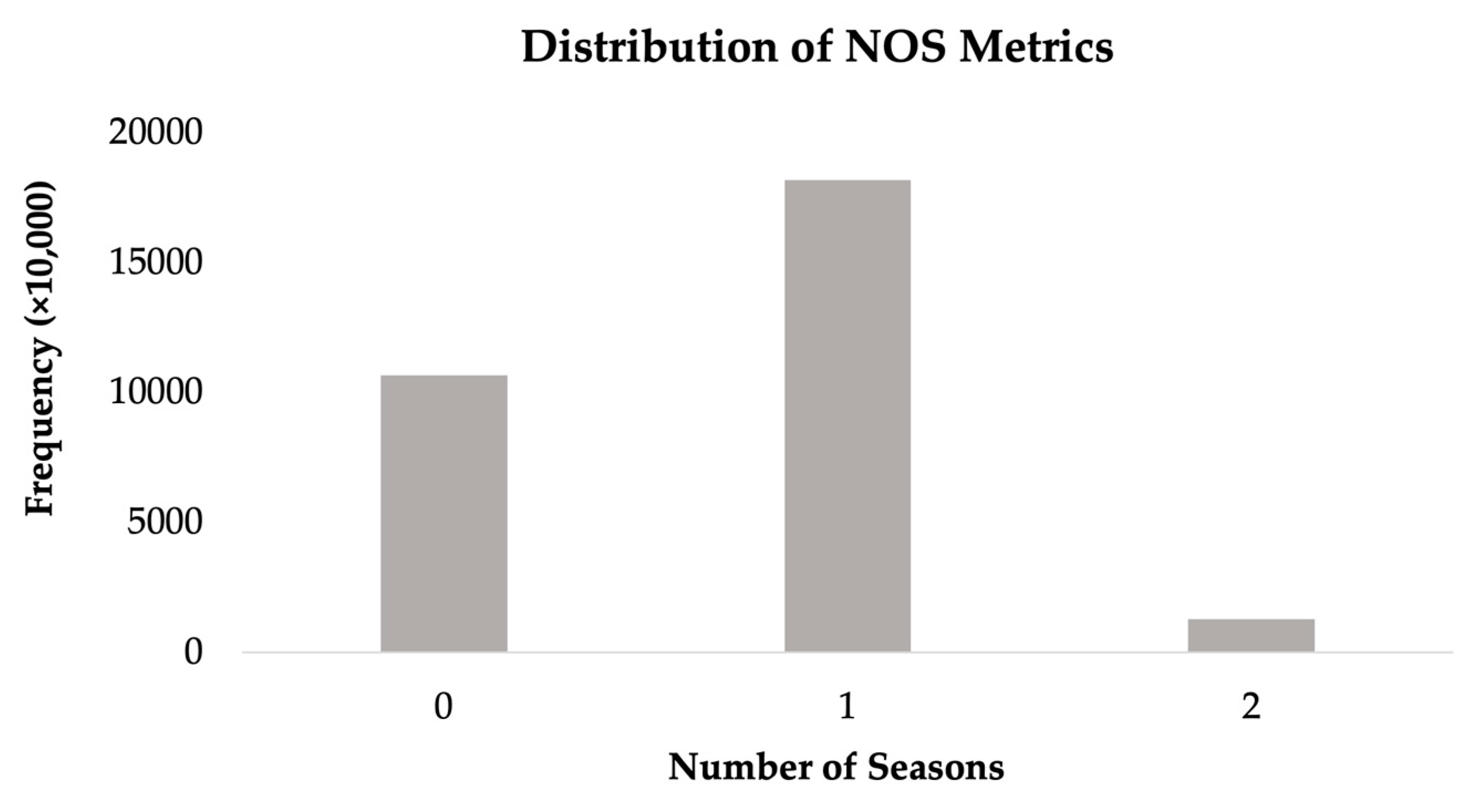
| Phenology Metric | Description |
|---|---|
| Start of season (SOS) | Day of year value identified by a consistent upward trend in NDVI starting at a 0.35 threshold. |
| Day of peak (DOP) | Day of year value identified by maximum NDVI value. |
| End of season (EOS) | Day of year value identified by a consistent downward trend in NDVI starting at a 0.35 threshold. |
| Length of season (LOS) | Number of days between SOS and EOS. |
| Green-up rate (GUR) | Positive rate of change in NDVI. |
| Green-down rate (GDR) | Negative rate of change in NDVI. |
| Number of seasons (NOS) | Number of growing periods within a year (365 days). |
| Maximum NDVI (NDVIMax) | Maximum NDVI value within the growing season. |
| Cumulative NDVI (NDVICum) | Sum of NDVI over the entire growing season. |
| Category | Land Cover in Study Area (%) | Evaluated Sample Fractions (%) |
|---|---|---|
| 1 | ≤0.01 | 100 |
| 2 | >0.01 and ≤0.1 | 40, 60, 80 |
| 3 | >0.1 and ≤1 | 4, 6, 8 |
| 4 | >1 and ≤10 | 4, 6, 8 |
| 5 | >10 | 0.04, 0.06, 0.08 |
| Combination | Sampled Fraction (%) | ||||||
|---|---|---|---|---|---|---|---|
| Category 1 | Category 2 | Category 3 | Category 4 | Category 5 | F-Score | OA (%) | |
| 22 | 100 | 40 | 6 | 8 | 0.04 | 0.81 | 91.77 |
| 13 | 100 | 40 | 6 | 6 | 0.04 | 0.81 | 90.78 |
| 40 | 100 | 40 | 6 | 6 | 0.06 | 0.81 | 90.53 |
| 67 | 100 | 40 | 6 | 6 | 0.08 | 0.81 | 90.29 |
| 4 | 100 | 40 | 6 | 4 | 0.04 | 0.81 | 89.81 |
| Class Number | Land Cover Class | F-Score |
|---|---|---|
| 280 | North American Warm Desert Lower Montane Riparian Woodland and Shrubland | 0.45 |
| 47 | Madrean Pinyon-Juniper Woodland | 0.47 |
| 469 | Madrean Juniper Savanna | 0.52 |
| 187 | Colorado Plateau Pinyon-Juniper Woodland | 0.61 |
| 472 | Sonora-Mojave Creosotebush-White Bursage Desert Scrub | 0.65 |
| 473 | Sonoran Mid-Elevation Desert Scrub | 0.67 |
| 459 | North American Warm Desert Playa | 0.69 |
| 358 | Mogollon Chaparral | 0.72 |
| 468 | Chihuahuan Succulent Desert Scrub | 0.73 |
| 46 | Madrean Encinal | 0.74 |
| 467 | Chihuahuan Stabilized Coppice Dune and Sand Flat Scrub | 0.75 |
| 474 | Sonoran Paloverde-Mixed Cacti Desert Scrub | 0.76 |
| 562 | Introduced Riparian and Wetland Vegetation | 0.80 |
| 461 | Apacherian-Chihuahuan Semi-Desert Grassland and Steppe | 0.81 |
| 282 | North American Warm Desert Riparian Woodland and Shrubland | 0.82 |
| 48 | Madrean Pine-Oak Forest and Woodland | 0.84 |
| 462 | Chihuahuan Creosotebush, Mixed Desert and Thorn Scrub | 0.85 |
| 443 | North American Arid West Emergent Marsh | 0.87 |
| 579 | Open Water (Fresh) | 0.87 |
| 540 | North American Warm Desert Pavement | 0.88 |
| 458 | Inter-Mountain Basins Playa | 0.89 |
| 539 | North American Warm Desert Bedrock Cliff and Outcrop | 0.89 |
| 547 | Inter-Mountain Basins Shale Badland | 0.90 |
| 444 | North American Warm Desert Riparian Mesquite Bosque | 0.91 |
| 460 | Apacherian-Chihuahuan Mesquite Upland Scrub | 0.91 |
| 541 | North American Warm Desert Volcanic Rockland | 0.92 |
| 476 | Sonora-Mojave Mixed Salt Desert Scrub | 0.93 |
| 553 | Undifferentiated Barren Land | 0.94 |
| 477 | North American Warm Desert Wash | 0.95 |
| 470 | Mojave Mid-Elevation Mixed Desert Scrub | 0.96 |
| 471 | North American Warm Desert Active and Stabilized Dune | 0.99 |
| Feature | Statistic | Quarter | Importance (%) |
|---|---|---|---|
| BLUE | Min, Max, Average | 2, 3 | 1.5–1.8 |
| EVI2 | Min | 3 | 1.7 |
| SWIR1 | Max | 2 | 1.5 |
Disclaimer/Publisher’s Note: The statements, opinions and data contained in all publications are solely those of the individual author(s) and contributor(s) and not of MDPI and/or the editor(s). MDPI and/or the editor(s) disclaim responsibility for any injury to people or property resulting from any ideas, methods, instructions or products referred to in the content. |
© 2023 by the authors. Licensee MDPI, Basel, Switzerland. This article is an open access article distributed under the terms and conditions of the Creative Commons Attribution (CC BY) license (https://creativecommons.org/licenses/by/4.0/).
Share and Cite
Melichar, M.; Didan, K.; Barreto-Muñoz, A.; Duberstein, J.N.; Jiménez Hernández, E.; Crimmins, T.; Li, H.; Traphagen, M.; Thomas, K.A.; Nagler, P.L. Random Forest Classification of Multitemporal Landsat 8 Spectral Data and Phenology Metrics for Land Cover Mapping in the Sonoran and Mojave Deserts. Remote Sens. 2023, 15, 1266. https://doi.org/10.3390/rs15051266
Melichar M, Didan K, Barreto-Muñoz A, Duberstein JN, Jiménez Hernández E, Crimmins T, Li H, Traphagen M, Thomas KA, Nagler PL. Random Forest Classification of Multitemporal Landsat 8 Spectral Data and Phenology Metrics for Land Cover Mapping in the Sonoran and Mojave Deserts. Remote Sensing. 2023; 15(5):1266. https://doi.org/10.3390/rs15051266
Chicago/Turabian StyleMelichar, Madeline, Kamel Didan, Armando Barreto-Muñoz, Jennifer N. Duberstein, Eduardo Jiménez Hernández, Theresa Crimmins, Haiquan Li, Myles Traphagen, Kathryn A. Thomas, and Pamela L. Nagler. 2023. "Random Forest Classification of Multitemporal Landsat 8 Spectral Data and Phenology Metrics for Land Cover Mapping in the Sonoran and Mojave Deserts" Remote Sensing 15, no. 5: 1266. https://doi.org/10.3390/rs15051266
APA StyleMelichar, M., Didan, K., Barreto-Muñoz, A., Duberstein, J. N., Jiménez Hernández, E., Crimmins, T., Li, H., Traphagen, M., Thomas, K. A., & Nagler, P. L. (2023). Random Forest Classification of Multitemporal Landsat 8 Spectral Data and Phenology Metrics for Land Cover Mapping in the Sonoran and Mojave Deserts. Remote Sensing, 15(5), 1266. https://doi.org/10.3390/rs15051266







